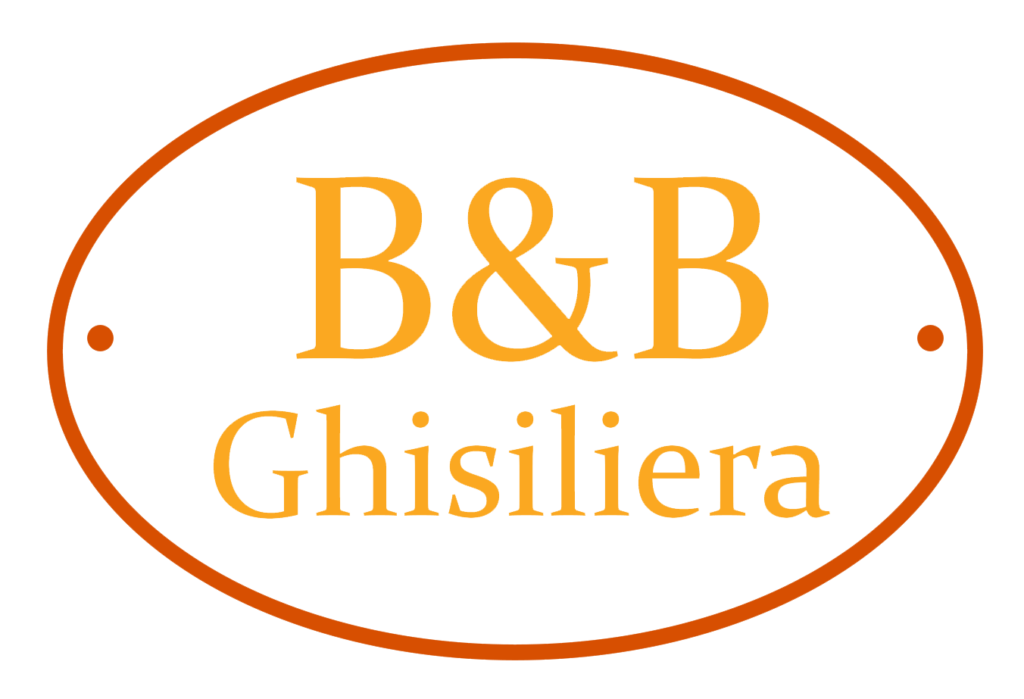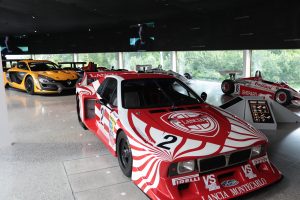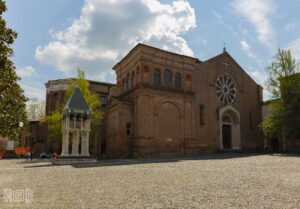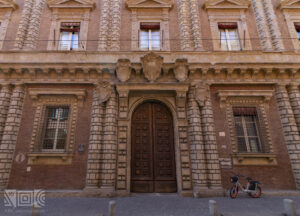Do you want to know the most important historical palaces in Bologna? Come and discover them with us!
Rocchetta Mattei
Located in the northern Apennines, in the municipality of Grizzana Morandi, Rocchetta Mattei is a centuries-old jewel born on the ruins of the ancient fortress of Savignano. The Rocchetta was born to jealously guard the secret of its patron: the self-taught physician Cesare Mattei. It was he himself who designed and built it in 1820, with the purpose of watching over his secret invention: a new method of curing diseases through plants and liquids called electric fluids. Within the walls of the palace, Dr. Mattei created secret mixtures that were to replace conventional medicine in the treatment of diseases.
The Rocchetta thus became not only his residence but also the center of his business affairs; in fact, the count made the decision to settle there after a railroad accident in which he was involved. Thus putting an end to his wanderings around the world. Within those walls he would die in 1896.
During his stay, Mattei transformed his house into a veritable medieval court where distinguished guests continually passed through. Among them was the writer and philosopher Dostoevsky, who even mentioned the Rocchetta in his novel “The Brothers Karamazov,” telling how the doctor’s drops saved him from rheumatism.
The building’s history is troubled as was that of its creator: After Mattei’s death during the war, German troops destroyed some of the interior of the fortress, thus making it uninhabitable. It was Primo Stefanelli who breathed new life into the building and restored it to its former glory by turning it into a hotel with an attached restaurant, making the fortress an attractive tourist destination. Upon his death (1989), however, every attempt was in vain because for various structural reasons the fortress was closed to the public. It reopened only in 2006, when the Cassa di Risparmio di Bologna foundation bought it and renovated it.
Inside you can admire “The Courtyard of Lions” characterized by having a fountain in the center with 4 lions at its base, from here you enter the “Hall of Peace” in honor of the end of World War II, exactly the same as the one found inside the Alhambra in Granada.
The building is quite distant from Bologna; however, it can be easily reached by car, taking the A1 highway with the exit at Sasso Marconi and continuing on the SP64 to branch-off No. 62 Riola – Camugnano – Castiglione dei Pepoli. The entrance overlooks this very road.
If you want to visit and learn about other famous villas in Bologna, I recommend reading: The most important historical buildings in the center of Bologna
Curiosity
Cesare Mattei began to take an interest in medicine following his mother’s diagnosis of breast cancer, upon her death this unconventional medicine became his obsession: in fact, he thought that electrohomeopathy could succeed where traditional medicine had failed.
The Rocchetta is a blend of different styles, transporting its visitors from East to West in a carnival of cultures and suggestions.
The Rocchetta is a succession of staircases, towers and labyrinths of rooms designed in every detail to build a magical place.
Visiting the Rocchetta is like entering a fairy tale, a place of mystery filled with esoteric symbols.
Hours and tickets
The cost of the ticket to visit the Rocchetta is 10 euros and it is mandatory to book your entrance from the website. The advice is to book the visit several time in advance as the places for the visit are sold out quickly.
Rocca Isolani
Rocca Isolani is an extraordinary building dating back to 1300 located in Minerbio, about 30 minutes from the center of Bologna.
The history of this building has been far from peaceful: in the course of its existence it has been affected by several nefarious happenings. Among these the worst of all is surely the fire caused by the fury of the Visconti leader Niccolò Piccinino, who destroyed it entirely in 1400. The Rocca we see today is the result of the reconstruction that took place in 1438.
After these events Rocca Isolani was entrusted to an important Bolognese family: the Isolani, the lords of Minerbio, from whom it was later named.
The challenges did not end there: about a century later it was attacked again. This time by mercenaries, the Landsknechts, who set fire to part of the building during their march on Rome. Fortunately, the last attack did not cause serious damage to the internal assets, especially the precious polychrome terracotta friezes depicting the Renaissance court, still present in the fortress, were not destroyed.
Today the Rocca is a refined location that combines luxurious surroundings with history and art. The Renaissance courtyard measures 450 square meters and can accommodate approximately 250 people inside; it also has museums, galleries, restaurants, and much more!
To this day it is a popular location for conventions, concerts and private receptions and princely weddings. In fact, inside there is a chapel where it is possible to celebrate Civil Weddings.
Curiosity
At the back of the fortress is the dovecote, which, on the occasion of his coronation in 1530, hosted none other than Charles V. He was in fact crowned emperor of the Holy Roman Empire in Bologna itself, more precisely in the Basilica of San Petronio.
Hours and tickets
You can always contact the palace Monday through Sunday from 8:00 a.m.
Villa Belpoggio Hercolani
Villa Belpoggio Hercolani is an imposing neoclassical-style villa located just outside the center of Bologna, after Porta Santo Stefano, precisely at 34/36 Via Siepelunga.
The villa took on this appearance after extensive reconstruction work involving several generations. Originally on that land stood the castle of Belpoggio, which later became a Villa after the intervention of Giovanni Bentivoglio II. It was at the end of the 1400s when Giovanni II decided to turn the castle of Belpoggio into the family’s summer residence, it united castle and palace in a single structure. At the fall of the Bentivoglio family there were several owners until, towards the end of the 1700s, it became the property of the Hercolani family when Lucrezia Orsi married Astorre Hercolani V Prince Hercolani. The entire complex was in fact part of Lucrezia’s dowry. Later the villa was bequeathed to the son of the two: Filippo. The latter began a new renovation, giving the mansion the appearance that we can all admire today.
A series of sculptures representing Apollo, Hygieia, Pomona and Euterpe were made on the ground floor of the building, which still adorn the entrance hall and loggia.
Within the 12 hectares of parkland, an early nascent example of an “English garden” and “romantic garden” can be seen due to the palace’s care and representative image.
During World War II, the mansion suffered considerable damage but a long and careful restoration brought the mansion back to its former beauty.
The Hercules
Of particular importance is the inclusion on the facade of a decoration made in 1784 by Giacomo Rossi depicting the family coat of arms positioned between two mighty figures of Hercules, with the commemorative inscription, “Philippus M.F. Hercolanius Exornamdam curavid.”
The two figures are positioned to guard the family coat of arms and are constructed of iron and masonry: these are two statues of magnificent size, recently restored due to their poor state of preservation. The degradation of the statues was such that some parts had to be rebuilt from scratch, among them almost all of the crown that surmounts the coat of arms.
Villa Baldi Sassoli
Villa Baldi Sassoli is a seventeenth-century villa positioned toward the northern border of Bologna’s territory at Via Cadriano 21. Proceeding from Bologna after Parco Nord, just before the medieval Borgo Dozza. The mansion, owned by the Marquises Baldi, consists of 2 parts: the 17th-century manor house and adjacent oratory.
The family that owned the villa was extremely influential, and so the structure acquired a central prominence at the time, to the point that the street next to it is named after it: Via Balda.
The ground floor of the villa is tastefully decorated with paintings dating from the 18th century (1700-1800), in which there is a prevalence of elements such as masks and foliage by the artist S.Orlandi.
At the back of the villa is the charming garden, still in its former beauty, within which, among the tall trees, a small theater had been created, the site of an 18th-century academy.
Adjacent to the building, on the other hand, is a wonderful deconsecrated eighteenth-century church and an old barn.
it is striking how in the villa there is a great contrast between the architectural simplicity with which the exterior facade is shown and the luxury inside, between lavish decorations and fine furniture that testify to how the life of a typical noble family in the Bolognese countryside was carried out.
Today this palace too, like Rocca Isolani, is often used as a location for weddings, charming events but also corporate parties and meetings.
Visitable all year round, it is often the site of themed exhibitions that fit well within its medieval walls.
Villa Cicogna
Villa Cicogna also known as Villa Boncompagni, is an ancient 16th-century noble residence. To get there you have to immerse yourself in an almost fairy-tale landscape: in fact, the road leading to the villa is nothing but an avenue all sprinkled with linden trees. It is located at the end of the Via Emilia, in the municipality of San Lazzaro di Savena. With its construction, dating back to 1578, the season of Bolognese villas was officially opened, which would later extend until the first half of the 19th century.
Designed by the famous architect Jacopo Barozzi known as “il Vignola,” whose other important works during his Bolognese period include: the design of the Basilica of San Petronio and Palazzo Boncompagni.
The villa was built for Marquis Giacomo Boncompagni, son of Pope Gregory XII.
In Vignola’s original plans, the structure was to be built on two floors, but in the end only one was built.
Inside the villa one can admire frescoes and decorations dating back to 1743 when Count Sicinio Pepoli, the owner who succeeded the Boncompagni and Colonna families, commissioned Carlo Lodi, a great landscape artist, to make 40 wall tempera paintings inside stucco frames.
In 1920 the villa was bought by industrialist Gaetano Barbieri, and in the 1980s it passed to the Villa Cicogna society.
It then became part of the UNIPOLSAI group in 2012. Since then it has been a venue for meetings, and cultural events.
Opening hours:
Monday, Wednesday and Friday 8 a.m.-12:30 p.m.
Tuesday 8 a.m.-1 p.m.
Thursday 8 a.m.-1 p.m., 2:30-6 p.m.
Bibliography:
- Guida ai palazzi di Bologna viaggio romantico tra gli edifici storici della città. Autore Maria Silvia Avanzato, Edizione della sera, data di pubblicazione 2020.
- Gli scaloni monumentali dei palazzi storici a Bologna. Autore G. Cuppini, editore Pátron, data di uscita 2009
- Le grandi famiglie di Bologna: palazzi, personaggi e storie. Autore Tiziano Costa, editore Costa, data di uscita 2007
- Monumenti di Bologna: distruzioni e restauri. Autore Alfredo Barbacci, editore Cappelli, data di uscita 1997





